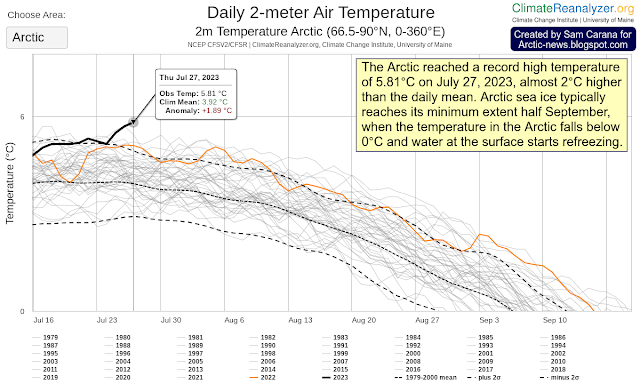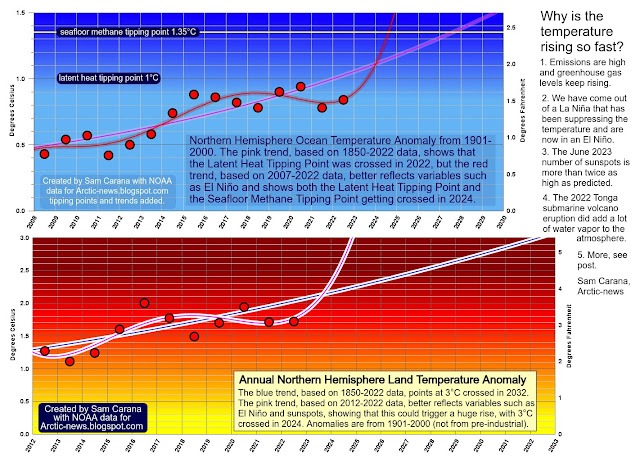As temperatures and humidity levels keep rising, a tipping point can be reached where the wind factor no longer matters, in the sense that wind can no longer provide cooling. The human body can cool itself by sweating, which has a physiological limit that was long described as a 35°C wet-bulb temperature. Once the wet-bulb temperature reaches 35°C, one can no longer lose heat by perspiration, even in strong wind, but instead one will start gaining heat from the air beyond a wet-bulb temperature of 35°C.
Accordingly, a 35°C wet-bulb temperature (equal to 95°F at 100% humidity or 115°F at 50% humidity) was long seen as the theoretical limit, the maximum a human could endure.
A 2020 study (by Raymond et al.) warns that this limit could be regularly exceeded with a temperature rise of less than 2.5°C (compared to pre-industrial). A 2018 study (by Strona & Bradshaw) indicates that most life on Earth will disappear with a 5°C rise. Humans, who depend for their survival on many other species, will likely go extinct with a 3°C rise, as illustrated by the image below, from an earlier post.
The image below show a high reading on the 'Misery Index', the perceived ('feels like') temperature that is used by nullschool.net, combining wind chill and the heat index (which in turn combines air temperature and relative humidity, in shaded areas). A Misery Index temperature of 56.1°C or 133.1°F was recorded at a location off the coast of the United Arab Emirates (green circle) on August 5, 2023.
This constitutes a warning. The sea, rivers and lakes are traditionally seen as places to go to, to cool off. However, high temperatures combined with high humidity over water bodies can result in conditions that go beyond what humans can bear.
The image below, earlier discussed here, expands risk assessment beyond its typical definition as the product of the severity of impact and probability of occurrence, by adding a third dimension: timescale, in particular imminence.
Thirdly, there are further tipping points, e.g. social-political ones. On the one hand, it would be good if people became more aware, as this could prompt more people into supporting the necessary action. On the other hand, as temperatures keep rising, there is also a danger that panic will break out, dictators will grab power and civilization as we know it will collapse abruptly, as warned about earlier, e.g. in 2007.
Links
• Wet Bulb Globe Temperature
https://digital.mdl.nws.noaa.gov
• National Weather Service - Wet Bulb Globe Temperature: How and when to use it
https://www.weather.gov/news/211009-WBGT
• The emergence of heat and humidity too severe for human tolerance - by Colin Raymons et al. (2020)
https://www.science.org/doi/10.1126/sciadv.aaw1838
• Brief periods of dangerous humid heat arrive decades early
https://www.climate.gov/news-features/featured-images/brief-periods-dangerous-humid-heat-arrive-decades-early
• Evaluating the 35°C wet-bulb temperature adaptability threshold for young, healthy subjects (PSU HEAT Project) - by Daniel Vecellio et al. (2022)
https://journals.physiology.org/doi/full/10.1152/japplphysiol.00738.2021
Discussed at: https://www.facebook.com/groups/arcticnews/posts/10159973158374679
• NOAA - Weather Fatalities 2022
https://www.weather.gov/hazstat
• The Effects of Heat Exposure on Human Mortality Throughout the United States - by Drew Shindell (2021)
• Heat-related mortality in Europe during the summer of 2022 - by Joan Ballester et al.
https://www.nature.com/articles/s41591-023-02419-z
• As Temperatures Spike, So Do Deaths from Heart Disease (2022 News release)
https://www.acc.org/About-ACC/Press-Releases/2022/03/22/20/06/As-Temperatures-Spike-So-Do-Deaths-from-Heart-Disease
• Association of Extreme Heat and Cardiovascular Mortality in the United States: A County-Level Longitudinal Analysis From 2008 to 2017 - by Sameed Khatana et al. (2022)
https://www.ahajournals.org/doi/10.1161/CIRCULATIONAHA.122.060746
• Co-extinctions annihilate planetary life during extreme environmental change, by Giovanni Strona and Corey Bradshaw (2018)
https://www.nature.com/articles/s41598-018-35068-1
Discussed at: https://www.facebook.com/groups/arcticnews/posts/10156903792219679
• When will we die?
https://arctic-news.blogspot.com/2019/06/when-will-we-die.html
• Climate Reanalyzer - Hourly Forecast Maps
https://climatereanalyzer.org/wx/fcst/?mdl_id=nam&dm_id=conus-lc&wm_id=t2
• PBS video - Too HOT and HUMID to Live: Extreme Wet Bulb Events are on the Rise
https://www.pbs.org/video/too-hot-and-humid-to-live-extreme-wet-bulb-events-are-on-th-fazocs
• Nullschool
https://earth.nullschool.net
• How agriculture hastens species extinction | 60 Minutes (CBS News) | Gerardo Ceballos
https://www.youtube.com/watch?app=desktop&v=f21WWocqR-c
• Biological annihilation via the ongoing sixth mass extinction signaled by vertebrate population losses and declines - by Gerardo Ceballos, Paul R. Ehrlich and Rodolfo Dirzo (2017)
https://www.pnas.org/content/114/30/E6089
• Vertebrates on the brink as indicators of biological annihilation and the sixth mass extinction - by Gerardo Ceballos, Paul Ehrlich, and Peter Raven (2020)
https://www.pnas.org/content/early/2020/05/27/1922686117
https://www.pnas.org/doi/10.1073/pnas.1809600115
https://www.onlinescientificresearch.com/articles/earth-is-in-the-midst-of-abrupt-irreversible-climate-change.pdf
• Ten Dangers of Global Warming
https://arctic-news.blogspot.com/p/ten-dangers-of-global-warming.html
• Extreme heat stress
• Transforming Society
https://arctic-news.blogspot.com/2022/10/transforming-society.html
• Climate Plan
https://arctic-news.blogspot.com/p/climateplan.html
• Climate Emergency Declaration
https://arctic-news.blogspot.com/p/climate-emergency-declaration.html









































